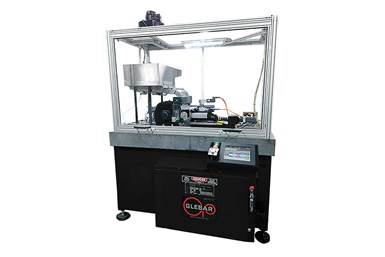Glebar Centerless Grinder’s Wider Work Wheel Increases Throughout
An oscillating regulating wheel powered by servo motors reduces setup time and improves sphericity.

Glebar’s PG-912DG enclosed centerless form grinder
Glebar’s PG-912DG enclosed centerless form grinder is designed to increase throughput, reduce setup times and achieve tighter tolerances. The company says the grinder also provides better integration for gages, automation and remote service diagnostics.
At the core of the PG-912DG is a 12"-wide work wheel which enables manufacturers to grind more material or parts per cycle, increasing throughput by as much as 30%. Glebar pairs the wider work wheel with an oscillating regulating wheel powered by servo motors to reduce setup time and improve sphericity. The slides can be programmed to finite positions through a touchscreen human-machine interface. When an operator selects a job, the servo motors automatically adjust to programmed positions, which reduces setup time.
The company says the position of the regulating wheel is critical to the accuracy of the grind. Using servo motors to position the regulating wheel creates greater repeatability in the grind and helps it maintain a tighter tolerance.
In one application example, a stainless-steel hopper automatically drops parts into the feeder channeling them into singular stations on the plunge grinder. Within a 14-second cycle, up to 12" of parts can be ground simultaneously. The servo-powered oscillating regulating wheel assembly rotates the balls randomly, improving sphericity. An interlocking safety enclosure and mist collector provide a safe and clean work environment. The granite machine bed helps to provide enhanced rigidity as well as thermal and vibratory stability. The high-speed, multi-axis control system can expand the machine functionality and includes the ability to remotely diagnose the machine and gather production data for reporting.
The grinder can grind most hard-to-turn materials such as carbon fiber, fiberglass and polypropylene, and is designed to grind parts as small as 0.050" to 4" diameter on the same machine. The company says spherical or cylindrical components can be shaped into unlimited forms on a large variety of materials such as rubber, plastics, carbon fiber, Teflon (PTFE) and various metals.
Related Content
-
Star Cutter Grinding Machines Improve Uptime, Throughput
Tru Tech grinding machines are designed to achieve high accuracy for high precision and micro components in numerous industries including medical, aerospace and electronics.
-
Studer S100 Grinding Machine For High-Precision, Flexible, Reliable Grinding
The machine is well suited for a wide range of internal, surface and external grinding applications, making it well suited for the entry-level market.
-
Emag Grinding Solutions Provide Precise Gear-Profile Grinding
The G 160 and G 250 gear-profile grinding machines provide short chip-to-chip times, intelligent axis concepts as well as thermal and mechanical stability.










.jpg;maxWidth=300;quality=90)





